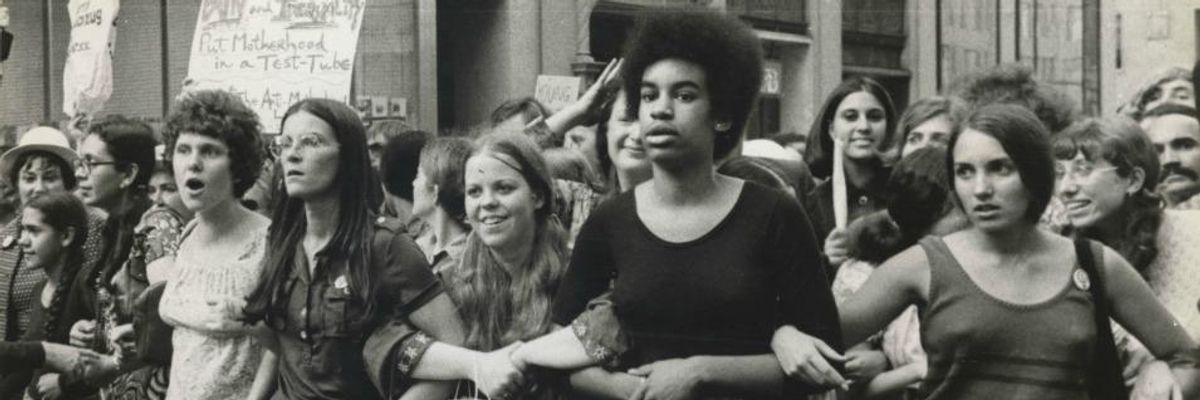Today is the anniversary of Roe v. Wade, the 1973 landmark Supreme Court decision that legalized abortion in the U.S. The decision did not simply affirm a woman's right to terminate a pregnancy, it ensured safe services for all women seeking an abortion. Forty-two years later, we no longer have the health crisis of women dying in "back alleys," but we do face a crisis rooted in economic inequality and women's struggles to obtain comprehensive reproductive health care, including abortion services. The onslaught of restrictions introduced and passed since 1973 compounds a stark reality for low-income women, women of color, and young women - Roe is not a reality for everyone.
In truth, the promise of Roe existed in both spirit and law for just 2 years. From 1973-1975 abortion was legal and covered by the Medicaid program, which ensured that low-income women had equal access to abortion care. But in 1975, Congress passed the Hyde Amendment that restricted federal dollars from paying for abortion services for poor women. Since then advocates, activists, and legislators alike have struggled to maintain the essence of Roe as state legislatures took the lead on passing laws reminiscent of a pre-Roe era.
For decades reproductive health, rights, and justice advocates have fought to protect the legalization of abortion only to see its access and availability eroded at both the federal and state levels. At the federal level, the Hyde Amendment spawned similar amendments that restrict abortion coverage for military personnel, veterans, federal employees, Peace Corp volunteers, Indian and Native women, and incarcerated women. And in 1992, the Supreme Court issued a divided judgment in Planned Parenthood of Southeastern Pennsylvania vs. Casey that weakened Roe considerably. On the one hand, it upheld key provisions of Roe, namely that states cannot ban abortion before the point of viability of the fetus. But it also ruled that states could regulate abortions to protect the life of the woman or the fetus; medical technology could alter the point of viability; and, no law could impose an undue burden on women to obtain legal abortion services. Moreover, the court found that the 24-hour waiting period laws were not an undue burden. This Supreme Court decision, unfortunately, is the law of the land.
These federal budget amendments and Supreme Court rulings opened the door for state legislators to incrementally - and creatively - circumvent a woman's right to determine if and when she will parent and to do so with dignity. Thus far, states have been allowed to pass extreme restrictions, and in doing so perpetuate a cycle of oppression for the most vulnerable women, namely those living in states with high rates of poverty, limited access to preventive services, and other regressive policies such as voter ID laws and right-to-work laws. According to the Guttmacher Institute, 30 states have enacted more than 205 abortion restrictions since 2011.
Texas, the poster child for anti-woman policies, offers proof of just how burdensome accessing abortion services can be for low-income women and families. Since 2013 Texas has cut family planning services and passed a law requiring doctors to have admitting privileges to a hospital within 30 miles, as one provision of the Targeted Regulation Abortion Providers (TRAP) legislation. Since the TRAP legislation passed Texas has gone from having 41 clinics to 17. A federal appeals court will determine this year if the TRAP building code provisions - such as the widening of hallways and increasing airflow - are constitutional. These new laws, combined with an already long list of restrictions, have made Texas one of the most hostile states for women's health in the nation. Previous restrictions include mandatory counseling that is biased; a 24-hour waiting period between counseling and having the procedure; mandatory ultrasounds; a prohibition on Medicaid coverage; and a prohibition on medication abortion provided via telemedicine.
Moreover, the cost for low-income women can be devastating. In Texas, one in six women must drive in excess of 200 miles to reach a clinic providing services. The 24-hour waiting period almost guarantees that those arriving from border towns or rural areas will have to pay for a hotel. If she is already a parent, as most women who have abortions are, she may need to pay for childcare too. Those working in low-wage jobs most likely do not have paid leave and could risk losing income or job if they take time off. And the cost of first trimester abortions without insurance coverage is approximately $500. But the longer a woman waits, the higher the costs will be. Research shows that too often women forgo basic needs - like paying rent - in order to obtain this legal medical procedure. Collectively or individually, these factors can force low-income women into worse financial circumstances.
We celebrate Roe as a standard and a vision that we must continue to strive for as a nation. All women, regardless of age, gender, income, socio-economic status, or funding source of insurance should benefit from its promise. And our fight for justice isn't done until all woman have comprehensive reproductive health care, including the access to abortion services.
